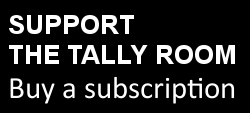10:15pm – I’m going to sign off here for the night. I’ll be back with another post tomorrow. As a summary, here are the key points:
- There has been a large swing against both the ALP and the Liberal Party, with the two major parties polling well under 60% of the primary vote.
- There have been large swings towards the Greens and the Palmer United Party, including positive swings in every electorate.
- The first two Liberal senators and the lead Labor and Greens candidates have polled a full quota, while the Palmer United Party is close enough to be very likely to win.
- The final seat looks likely to be a race between the Liberal Party’s Linda Reynolds and the Labor Party’s Louise Pratt. At the time of writing, Pratt leads on the ABC Senate calculator, but a lot of votes remain to be counted, and Pratt’s lead is extremely slim.
10:10pm – And Louise Pratt of the ALP has now gained the lead on the ABC Senate calculator, which just demonstrates how tight this race is.
10:01pm – Both the Liberal Party and the ALP have suffered negative swings in all 15 electorates. The Greens and the Palmer United Party gained positive swings in all 15 electorates. The swing to the Greens was weakest in the very rural electorates of Durak and O’Connor. The Greens achieved swings of 8% or over in the inner-city seats of Fremantle, Perth, Swan and Tangney.
9:57pm – In terms of the geographic spread, I’m probably going to stop updating my figures at this point, since the ABC data is very good-quality. I’ll come back tomorrow with some more analysis of the swings and geographic balances. For now I’ll just focus on some broad trends.
9:46pm – We have just under 40% of the vote counted, and there’s a pretty clear pattern. The Liberal Party has won two seats,the ALP, the Greens and the Palmer United Party, and the final seat is a race primarily between the Liberal Party’s Linda Reynolds and the ALP’s Louise Pratt. At the moment, Antony Green’s Senate calculator has Reynolds winning by a margin of 0.02 quota, which is definitely vulnerable. That will be the race to watch.
9:40pm – The Greens have overtaken the ALP in both Curtin and Tangney.
9:02pm – The PUP vote ranges from 4.4% in Curtin to 17.6% in Brand. Swing ranges from 2.3% in Perth to 10.2% in Brand.
8:54pm – Let’s look at the vote for the larger parties in each electorate. The Greens vote varies from 6.8% in O’Connor to 27.1% in Perth. Swings from +0.1% in O’Connor to +13.9% in Perth.
8:39pm – Antony Green’s projections suggest the Greens aren’t that far behind Labor overall.
8:22pm – The swing against the ALP ranges from 0.5% in Curtin to 10% in Tangney.
8:20pm – It seems pretty clear that five of the six seats will go to two Liberals, one Labor, one Green and one Palmer, with the last seat seemingly a race between the ALP and the Liberal Party.
8:18pm – My projections are as follows:
- LIB – 2.25 quotas increases to 2.32
- ALP – 1.09 to 1.36
- GRN – 0.92 to 1.20
- PUP – 0.89 to 0.84
- NAT – 0.94 to 0.41
7:47pm – Antony Green is matching results to booths from last time, and he suggests a trend that has the Liberal Party only just over two quotas, with the ALP on about 1.5 quotas, the Greens over a quota and PUP just under a quota.
7:45pm – Out of seven electorates that have reported votes so far, the Greens are up in five seats. This includes an increase of 6% in Pearce and Stirling, and 14.3% in Brand. Bear in mind that we don’t know if the booths reporting so far are representative of the entire electorate.
7:41pm – My model, which weights the vote in each electorate according to the number of votes polled in 2013, halves the National vote from 19.2% to 9.5% and increases the ALP vote from 13.8% to 19.5%. It also increases the Greens vote from 7.7% to 12.1%. Bear in mind we still have no votes from eight urban seats, and this model will become more useful once all 15 seats have reported votes.
7:39pm – We now have over 8000 votes – which is 0.62% of the votes recorded in 2013. In O’Connor that ratio is over 4%, with most of the other seats conservative and rural.
7:05pm – We have votes now from five conservative seats: Canning, Durack, Forrest, Pearce and O’Connor. This is enough to see that O’Connor is well over-represented. The vote reported in O’Connor is at 0.8% of the 2013 vote, which is a much larger ratio than any of the other seats.
6:49pm – So far we’ve got less than 200 votes, most from O’Connor and a small number from Pearce.
6:44pm – Sam Dastyari on ABC News 24 claims that a sample of large booths suggest a drop of 15% in turnout.
6:00pm – Polls have just closed in Western Australia, and I’ll be covering the results here on the website.
I’ll be using a new model to try and track how the results are flowing in, and to take account of trends that are not uniform between seats. In short, I will be scaling up each seat’s vote to 80% of the turnout at the 2013 election, which will weight votes more heavily from seats where they haven’t reported. This isn’t perfect, as voting patterns will vary within each electorate, and my model won’t be able to match booths individually to get a more precise sense of the swing.
I’ll be tracking how the results are going in each seat, and what sort of swings we are looking at. I’ll then be relying on Antony Green’s Senate calculator to get a sense of how those primary votes will translate into a result.
